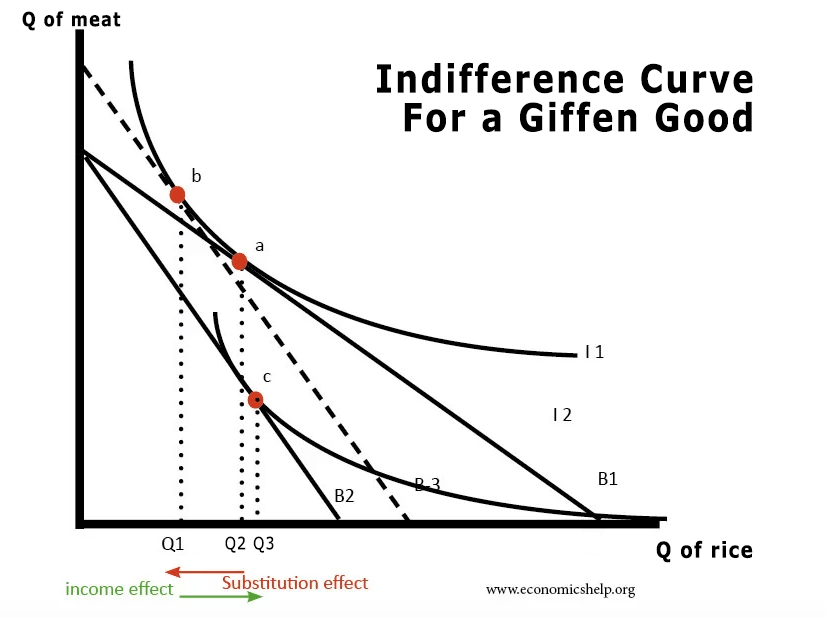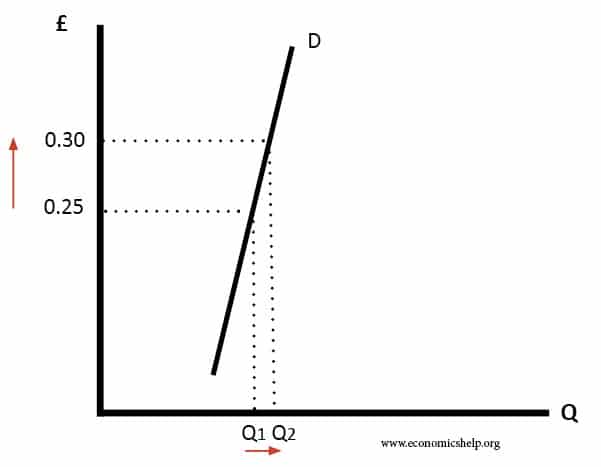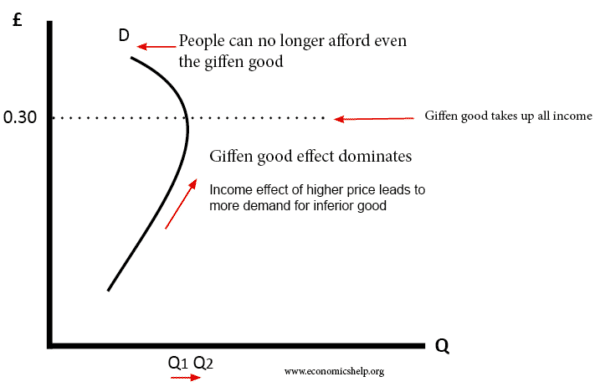Definition of a Giffen Good. A good where a higher price causes an increase in demand (reversing the usual law of demand). The increase in demand is due to the income effect of the higher price outweighing the substitution effect.
- The concept of a Giffen good is limited to very poor communities with a very limited choice of goods. Empirical evidence is hard to find, though some economists thought it applied to the Victorian poor who had a very limited diet.
The idea is that if you are very poor and the price of your basic foodstuff (e.g. bread) increases, then you can’t afford the more expensive alternative food (meat) therefore, you end up buying more bread because it is the only thing you can afford.
“As Mr.Giffen has pointed out, a rise in the price of bread makes so large a drain on the resources of the poorer labouring families and raises so much the marginal utility of money to them, that they are forced to curtail their consumption of meat and the more expensive farinaceous foods: and, bread being still the cheapest food which they can get and will take, they consume more, and not less of it.
Suppose you have a very low income and eat two basic foodstuffs rice and meat.
- Meat is a luxury and is much more expensive than rice.
- If rice increased in price, your disposable income is effectively reduced significantly.
- Therefore, with a reduction in disposable income – you buy less meat
- To compensate for less meat, you buy more rice to gain enough calories.
It is quite rare and whether it really happens has a little uncertainty. But, it shows that there are two factors affecting demand price (substitution effect) and income.
With a Giffen good, if rice continues to rise in prices, demand may eventually fall because the poor workers will not be able to even afford rice.
Diagram of Giffen good
Readers question: This post reminded me of a similar situation: a Giffen good. In fact, Veblen goods and Giffen goods seem to be extremely similar, and I was hoping you could clarify the difference between the two!
The law of demand says a higher price leads to lower demand. However, there are two exceptions
- Veblen Good. In this post, we defined a Veblen Good (sometimes known as ostentatious good). The basic principle is that as price rises people buy more. This is because people think if it is more expensive it must be better quality. This is possible for some designer clothes e.t.c. WIth a Veblen good, the demand curve is shifting to the right – rather than demand upwardly sloping like Giffen good.
- Giffen Good. A Giffen good has the same affect – higher price leads to higher demand. But, it is for a completely different reason. A Giffen good occurs when a rise in price causes higher demand because the income effect outweighs the substitution effect.
Indifference curve analysis and Giffen Goods

We start at Q2, the rise in the price of rice, reduces the budget line for rice to B2. But, the fall in income causes a large income effect that outweighs the substitution effect. Demand for rice rises to Q3 with a big fall in demand for meat.
For more details on indifference curves.
Related



Thanks very much – that really clears things up.
You say Giffen goods are rare. Either I misunderstand or you’re very wrong!
You go and stay in a hotel for a week.
Three weeks of the year you go camping.
Camping prices go up.
You still camp but go to a hotel only for a week-end.
To compensate you go camping for longer.
Hey presto!
A Giffen good.
(See my question about prostitutes and giffen goods…)
sarah, is the camping a necessity? If it is not than they might do less camping unless the value of the camping is higher to them than the hotel.
Camping and hotels are not the same as rice and meat, as FOOD is a necessity and vacationing is not.
Now if you have funds purely for hotels and camping…then how you distribute those funds is the issue. So, what is needed most is considered first and then…
I think you get the picture.
This is the comment I left on the blog about Veblen Good:
I tried to bring about the Veblen Good in my microeconomics class when we talked about giffen goods.
I had to do a bit by myself for the teacher (give her a chance, she just began teaching!) didn’t quite knew about Veblen goods.
So I simply classified goods in the three well known general categories which are Normal, Inferior and Superior. Inferior goods are either ordinary or giffen goods, whereas Superior goods are either ordinary or Veblen goods.
I think you are all familiar with the difference between the 2 types of inferior goods, that is, both have a negative income-elasticity, both have an income effect that varies in the same direction as the price variation, and both have a substitution effect that varies in the opposite direction as compared with the price variation. The two differences between both are:
1. An ordinary inferior good has a negative price-elasticity (same as a normal good) whereas a Giffen good’s is positive (see potatoes example above)
2. A Giffen good’s income effect offsets the substitution effect, whereas the contrary happens for an ordinary inferior good (which explains the positive-sloped demand curve for Giffen goods)
Now let me explain you my reasoning concerning the difference between the two types of superior goods. I might be wrong, I have no mathematical support for this (yet, I’ll come back to you about this real soon).
An ordinary superior good has exactly the same properties as a normal good, with the exception that its income-elasticity exceeds 1 (a normal good’s is between 0 and 1), which means that consumption variation is greater than the revenue variation (both vary in the same direction).
A Veblen good, which is where I present my reasoning, is different from an ordinary superior good in two ways:
1. Whereas the income effect, just like the ordinary superior good, varies conversely to the price variation, a Veblen good’s substitution effect varies along (wish I could underline that word!) with the price variation. This is the only type of good, altogether with every ones I’ve categorized above, for which the substitution effect would vary in the same direction as the price variation. That makes sense: substitution effect reflects the variation in the good’s demand resulting from a variation in its price relatively to any other good (say a composite good, which represents any other good), assuming purchasing-power-variation-adjusted budget. The above discussion summarizes to my opinion quite well what a Veblen good represents (either through snob effect or bandwagon effect).
2. The other difference is that, resulting from (and requiring) the fact that the substitution effect offsets the income effect, the demand curve will be positive-sloped, just like a Giffen good.
All of this seems to checkout in slutsky’s equation, which is yet to be confirmed. I’ll come back to you about that
Gold is the quintessential giffen good.
The higher the price, the more people want it, nobody cares about gold when it is cheap.
Surely that would make it a Veblen good, not a Giffen good? I’m still trying to get my head around these
That is a Veblen good
please can you state an example of Giffen ?????
examples of Giffen Good: maize meal in most African countries, bread, rice, a car in an organization that deals with delivery
I want to know that why bank interest is to low ?in nowadays
thank you very much. its now clear
Why it call arc elasticity of demand
Giffen goods should properly be defined to cater for the ordinary people.
I work hard, I insist, I will succeed
10 years later and in fact Sarah is correct.
5 nights camping. 2 nights hotel. You need somewhere to live but you have limited funds.
Camping is more expensive.
Only afford 4 nights camping and 2 nights hotel.
Cut back on hotel to give 5 nights camping and 1 night hotel.
Have extra night camping to compensate for hotel loss.
Giffen!
This applies to many many many example.